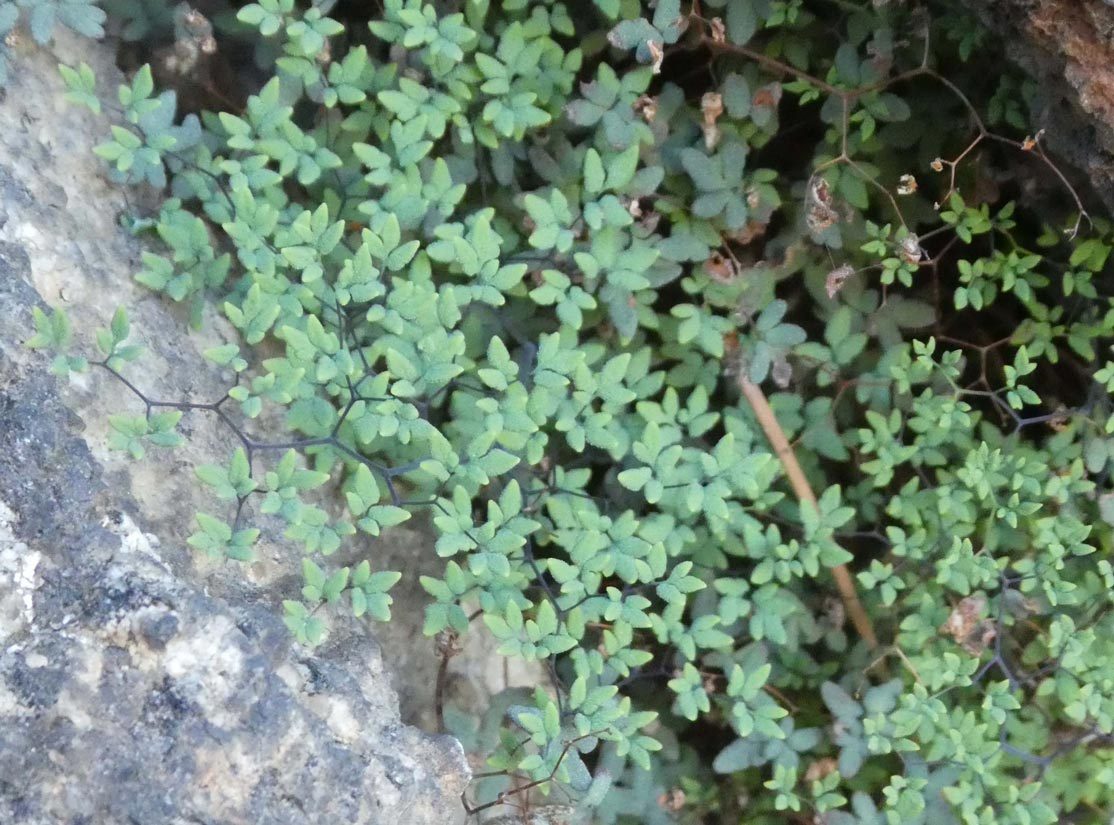


Ferns and Fern Allies
Introduction to Ferns
Ferns are some of the oldest plants on Earth, with fossils from modern fern families dating back to the Triassic period! Like flowering plants, ferns have roots, stems, leaves, and similar photosynthetic pigments. Unlike flowering plants, ferns do not produce seeds or flowers. Instead, they reproduce sexually by producing spores. If you look at the underside of the fern frond, you will see sporangia, which are little clumps of spores. The fern, in a process called meiosis, has created the spores which have one set of chromosomes. The spores are transported by wind or water to a new location where they grow into a gametophyte, which in many of our ferns looks like a little flat green heart, about the size of a fingernail.
The gametophyte has both male organs called antheridium which produce sperm, and female organs called an archegonium which produce eggs. The eggs and sperm mature at different times to maximize the possiblilty of cross-fertilization with other gametophytes.
In a process called mitosis the sperm fertilizes the egg creating a zygote. This is the leafy plant that we recognize as a fern and is the sphorophyte generation and has two sets of chromosomes.
Some ferns can reproduce vegetativly by producing bulblets which are small vegetative buds that grow on the fronds which, when pressed to the ground, produce new plants. There is also a species called a walking fern which has a unique way of reproducing. When the tips of the frond touch the ground, a new fern develops from the tip.
Some Fern Photos
Ferns are in order by scientific name.
Click on the photo to get started.
Scroll through using the left & right arrows.
Click the “i” to see information about the plant and the bottom down arrow remove the thumbnail carousel.
Click the arrow on the bottom-left to see a slide show.
Fern Allies
Fern allies are considered relatives of the ferns because they alternate between sporophyte and gametophyte generations, and reproduce by spores. Their main difference is that they do not have the same leaf structure.
The horsetails, in the Equisetaceae family, look like scrubbing brushes and have jointed stems that can be branched or unbranched and some species (not found in Colorado) can reach 15 feet in length. Their leaves are small scales along the stem which are not photosynthetic. The stems have silica deposits along the stems, which are very abraisive, and were used in the past to scrub pots and pans.
Club mosses in the Lycopodiaceae family, and spike mosses in the Selaginellaceae family, are more like ferns. They have true stems, roots and tiny leaves called microphylls which have a single vein.
Fern Identification
Ferns are known for their pinna (leaf fronds) and sori. The shape, size, texture and degree of complexity of frond varies from species to species. In the photos to the left you will see several native species of ferns, their habitats and identifiers. If you would like a key and further descriptions of native ferns, consider checking out “Colorado Ferns” by Harington and Durell.
Where to find them
Ferns in Colorado can be found in three types of habitats: moist, shady forests, crevices in rock faces, and acid wetlands.. While Colorado isn’t known for its ferns, there are over 60 native species and varieties in the state. Most of these are small plants, typically hidden among rock crevices. The next time you take a hike be sure to look among the shaded areas and slopes. There are also some species that are known to form colonies in forested areas. The brackenfern is a good example of this as it will form dense groups under aspen trees.
Moonworts
Moonworts are only distantly related to ferns. It’s not about photosynthesis, rather it’s because 1) morphology – they have the fruit bearing part (sporophore) on its own stalk set apart from the leaf part (trophophore). In ferns the sporophores are attached directly to the fronds (leaves), on the backs of the fronds and some have indusia. In moonworts the spores occur in sporangia on their own stalked entity, ot on the undersides of fronds. And 2) cytologically they are different, we can see this as moonwort’s do not unfurl when they elongate whereas ferns unfurl their fronds like in fiddlenecks. But Sceptridium in moonwort family does unfurl its leaf but that is still different than a frond. Also neither of these have true leaves but that is another story.
Plants resembling modern looking moonwort family plants appear in fossil record in N America 66 million years ago at start of Tertiary Period, who knows how much farther back they go and we simply have not found the fossils. Yet. Modern-resembling ferns appear in Devonian, 340 million years ago. But both are very ancient types of primitive plants and it gets complicated when talking about which are “older.”
Members of Ophioglossaceae are considered “fern like” or “fern allies”. They are definitely not true ferns! Closer to ferns than to monocots or dicots that evolved away from having spores. Spores = ancient plants, like bryophytes, ferns, and fern allies including moonworts.
– Steve Popovich

